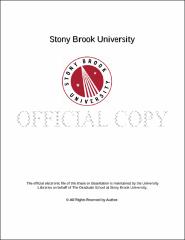| dc.identifier.uri | http://hdl.handle.net/11401/76893 | |
| dc.description.sponsorship | This work is sponsored by the Stony Brook University Graduate School in compliance with the requirements for completion of degree. | en_US |
| dc.format | Monograph | |
| dc.format.medium | Electronic Resource | en_US |
| dc.language.iso | en_US | |
| dc.publisher | The Graduate School, Stony Brook University: Stony Brook, NY. | |
| dc.type | Dissertation | |
| dcterms.abstract | Acid Sphingomyelianse (ASM) is a key regulatory enzyme that produces the bioactive lipid ceramide, which is converted into other sphingolipids by enzymes such as Ceramide Kinase (CERK). Previous literature has implicated ASM and CERK in inflammatory signaling, but the specific role of ASM and CERK as mediators of inflammatory signaling in breast cancer has remained elusive. In this work, we delineated the role of ASM in p38 activation and subsequent IL-6 production, as well as the role of CERK as a downstream effector of activated ASM. Since previous literature has shown that TNF-α induced dramatic alterations in the sphingolipid profile of cells, sphingolipidomic analysis was carried out on TNF-α treated MCF7 cells. The data revealed that TNF-α induced robust production of ceramide-1-phosphate (C-1-P) that accompanied an increase in CCL5. Given that previous literature showed CCL5 production is dependent on ASM, this data suggested that CERK may be acting downstream of ASM to produce C-1-P and induce CCL5. Indeed, siRNA ablation of CERK decreased CCL5 production. Furthermore, previous literature implicated C-1-P in Golgi localization of cPLA2. To define a role for ASM as an upstream modulator of CERK activity, the requirement for ASM in cPLA2 localization was tested. Ablation of ASM blocked cPLA2 localization to the Golgi network, suggesting ASM is acting upstream of CERK. Since ASM appeared to have Golgi specific functions, ASM mutants that accumulate in the Golgi network were tested for the ability to induce CCL5. We found that Golgi targeted ASM can induce CCL5 production. Taken together, these results demonstrate a role for CERK and C-1-P in CCL5 production and a role for ASM in modulation of CERK function. These results highlight the previously unappreciated role of C-1-P in CCL5 production and present new opportunities for targeting sphingolipid metabolism in treatment of breast cancers. | |
| dcterms.abstract | Acid Sphingomyelianse (ASM) is a key regulatory enzyme that produces the bioactive lipid ceramide, which is converted into other sphingolipids by enzymes such as Ceramide Kinase (CERK). Previous literature has implicated ASM and CERK in inflammatory signaling, but the specific role of ASM and CERK as mediators of inflammatory signaling in breast cancer has remained elusive. In this work, we delineated the role of ASM in p38 activation and subsequent IL-6 production, as well as the role of CERK as a downstream effector of activated ASM. Since previous literature has shown that TNF-α induced dramatic alterations in the sphingolipid profile of cells, sphingolipidomic analysis was carried out on TNF-α treated MCF7 cells. The data revealed that TNF-α induced robust production of ceramide-1-phosphate (C-1-P) that accompanied an increase in CCL5. Given that previous literature showed CCL5 production is dependent on ASM, this data suggested that CERK may be acting downstream of ASM to produce C-1-P and induce CCL5. Indeed, siRNA ablation of CERK decreased CCL5 production. Furthermore, previous literature implicated C-1-P in Golgi localization of cPLA2. To define a role for ASM as an upstream modulator of CERK activity, the requirement for ASM in cPLA2 localization was tested. Ablation of ASM blocked cPLA2 localization to the Golgi network, suggesting ASM is acting upstream of CERK. Since ASM appeared to have Golgi specific functions, ASM mutants that accumulate in the Golgi network were tested for the ability to induce CCL5. We found that Golgi targeted ASM can induce CCL5 production. Taken together, these results demonstrate a role for CERK and C-1-P in CCL5 production and a role for ASM in modulation of CERK function. These results highlight the previously unappreciated role of C-1-P in CCL5 production and present new opportunities for targeting sphingolipid metabolism in treatment of breast cancers. | |
| dcterms.available | 2017-09-20T16:51:23Z | |
| dcterms.contributor | Hannun, Yusuf A | en_US |
| dcterms.contributor | Cao, Jian | en_US |
| dcterms.contributor | Obeid, Lina M | en_US |
| dcterms.contributor | Luberto, Chiara. | en_US |
| dcterms.creator | Newcomb, Benjamin J | |
| dcterms.dateAccepted | 2017-09-20T16:51:23Z | |
| dcterms.dateSubmitted | 2017-09-20T16:51:23Z | |
| dcterms.description | Department of Biochemistry and Cell Biology | en_US |
| dcterms.extent | 167 pg. | en_US |
| dcterms.format | Application/PDF | en_US |
| dcterms.format | Monograph | |
| dcterms.identifier | http://hdl.handle.net/11401/76893 | |
| dcterms.issued | 2016-12-01 | |
| dcterms.language | en_US | |
| dcterms.provenance | Made available in DSpace on 2017-09-20T16:51:23Z (GMT). No. of bitstreams: 1
Newcomb_grad.sunysb_0771E_12775.pdf: 3633291 bytes, checksum: 3fdc6440f94df06509ed0a3c081bdd2b (MD5)
Previous issue date: 1 | en |
| dcterms.publisher | The Graduate School, Stony Brook University: Stony Brook, NY. | |
| dcterms.subject | Acid Sphingomyelinase, CCL5, Ceramide, Ceramide-1-Phosphate, Ceramide Kinase, Sphingolipid | |
| dcterms.subject | Biology | |
| dcterms.title | Sphingolipids in Breast Cancer Progression and Inflammatory Responses | |
| dcterms.type | Dissertation | |

